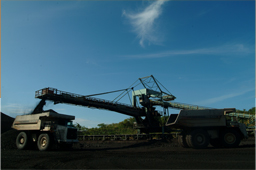
Community Newsletters
News Articles
Events
2024 Annual Stockholders' Meeting
2023 Annual Stockholders' Meeting
2022 Annual Stockholders’ Meeting
2021 Annual Stockholders’ Meeting
2020 Annual Stockholders’ Meeting
Reports and Presentations
COVID-19 Response

Unexpected treasures at Semirara
MANILA, Philippines - This patch of earth an hour’s flight from Manila is full of surprises and contradictions. Where, for instance, can one find huge piles of pitch black, smoking and scorching dry coal in one area and the clearest sky blue waters at the other end?
Welcome to Semirara Island, part of the municipality of Caluya in the province of Antique in the Western Visayas region. The island itself has an area of 55 square kilometers and is home to the country’s richest coal reserves.
Semirara Mining and Power Corporation (SMPC) has the exclusive rights to explore, extract and develop the island, the largest coal mine in the country.
Semirara Island is one of the three (3) islands in Antique declared by President Quezon as coal mining reservation sites by virtue of Proclamation No. 649 in 1940. The other two islands are Sibay and Caluya.
From an initial annual coal production of 806,451 tons run-of-mine (ROM) coal in 1997, the company was able to produce 12 million MT ROM coal in 2016. It remains a major source of the country’s coal requirements – from power plants to cement factories.
But somewhere deep into the forests of Semirara Island, past wild bushes, dusty rolling hills and across a maze-like terrain, is a piece of paradise, perhaps the island’s best kept secret.
The air is fresh, the sky is blue, the plants are green and there is a beach with fine sand and crystal clear waters.
Often dismissed as one bottomless pit of coal, the island is also home to the Semirara Marine Hatchery Laboratory, a facility dedicated to propagating endangered and precious marine species, namely giant clams, corals and abalones.
The hatchery is the island’s other treasure, as valuable as its vast coal reserves.
It was established by SMPC in 2010 to lead the marine rehabilitation efforts of the company and to develop sustainable marine-based livelihood for its host communities. Three National Scientists helped SMPC establish the hatchery.
Dr. Angel Alcala, a marine biologist and former Department of Environment and Natural Resources (DENR) Secretary was among the National Scientists who assisted SMPC.
Today, the hatchery operates dozens of giant bathtub-like containers by the beach for the breeding, culture and propagation of giant clams.
“Semirara, despite being just a small island, has all the species of giant clams in the Philippines,” Alcala tells STARweek.
Giant clams or Tridacna gigas are the largest mollusks on earth. They live in the warm waters of the South Pacific and Indian Oceans. These clams can be as gigantic as 140 centimeters in length and weigh 265 kilograms.
Alcala further explains that these bottom-dwelling behemoths achieve their enormous proportions by consuming the sugars and proteins produced by the billions of algae that live in their tissues.
Giant clams promote healthy marine ecosystems because they are filter feeders, says Alcala.
This means that they sip seawater from the surface and filter the plankton for their food and then release clean, clear water back to the surface.
“They produce their own food with the aid of sunlight. They are like plants – what they need, they can produce. They can photosynthesize. They can live without organisms,” Alcala explains.
In exchange, Alcala says, they offer the algae a safe home and regular access to sunlight for photosynthesis, basking by day below the water’s surface with their fluted shells open and their multi-colored mantles exposed.
They promote diversity where they live as they attract corals, fishes and smaller marine biota and, due to their symbiotic relationship with the corals, these giant clam sites serve as shelter areas and spawning ground of other marine organisms.
These sites also serve as feeding grounds of small fishes because of their waste materials. This means that epiphytes and algae attached to the shells serve as food for juvenile fishes and other crustaceans and corals.
In all, Alcala explains, these giant clams indicate whether the surrounding marine environment is clean. Giant clams are good bio indicators, which is why SMPC reseeded 150 juveniles of the Tridacna gigas, the largest of the giant clams species, along the coast of Semirara Island as early as 2006.
“To determine the impact of the company’s operations on the environment, we use giant clams. If they can survive in seawater, the water is fit for marine life,” Alcala says.
Unfortunately, giant clams are now an endangered species under the Convention on International Trade of Endangered Species of the Wildlife Flora and Fauna of 1982.
Extensive harvesting for food and the aquarium trade have drastically reduced their population in the wild.
The Semirara Marine Hatchery is working double time to help reverse the decline.
Dr. Ronnie Estrellada works full-time in the marine hatchery together with his staff of around 20. As head and chief marine biologist of the facility, Estrellada oversees the breeding and propagation of giant clams, transplantation of corals and culture of abalones.
It’s not an easy task. Estrellada says the hatchery operates round the clock. There are no holidays; otherwise, the clams will go hungry. The right amount of water, algae, sunlight and tender loving care are the requirements for a successful hatchery.
“For about six years of operation on the propagation and culture of the seven endangered species, we produced 161,000 pieces of clams and we are the only marine hatchery in the Philippines where the seven endangered species of giant clams are found,” he says.
The Semirara hatchery has also been reseeding giant clams – about 71,000 pieces with sizes ranging from 15 to 45 centimetres shell length around the island of Semirara.
SMPC supports the spawning and reseeding of these giant clams to continuously monitor the conditions of marine life in the island, Estrellada says.
“If the marine environment is polluted, the clams will die,” he says.
To help increase the giant clam population even outside the island, the hatchery has been donating these large mollusks to various organizations.
In 2015, it donated one hundred pieces of giant clams to DENR – Batangas Province, for reseeding in the Verde Island passage.
The Verde Island passage is considered as the world’s “center of the center of marine shore fish biodiversity”.
Last January, the hatchery also distributed 100 giant clams to the National Sun Yat-sen University in Kaohsiung, Taiwan. Another donation to a major university in Mindanao is also in the works.
SMPC’s marine rehabilitation efforts in Semirara Island has been recognized internationally. For instance, it was named first runner-up in the Corporate Social Responsibility category of the Asean Energy Awards in Kuala Lumpur, Malaysia in 2015.
Moving forward, the company has even bigger plans.
At present, Estrellada says, the company is working with the local government, host community, local fisherfolks and Dr. Alcala to establish two marine protected areas (MPAs) in Semirara Island.
Establishment of the MPAs will stabilize the coral reef systems and allow the fish stock in the island to recover from years of destructive and excessive fishing.
However, it would also require a change in fishing practices because local fishermen would no longer be allowed to fish in these “no-take” reserves.
To mitigate the impact of the MPAs on the local communities’ livelihood, SMPC will install 15 units of Fish Aggregating Device (FAD) all over the island.
Alcala says these FADs will attract fishes. With these FADs, the fishermen will be able to get fish that are pelagic or those that live in the pelagic zone of ocean or lake waters. They are neither close to the bottom nor near the shore.
“We are now working with stakeholders. The MPAs can increase the biomass of these fishes in shallow coastal areas. But for deeper areas the FADs will be there,” Alcala says.
At the same time, the Semirara Marine Hatchery is propagating more giant clams for future reseeding in the identified MPAs. It is also conducting coral and seagrass transplantation activities to help rehabilitate damaged coral reefs and attract more marine biota to the area.
With all these initiatives, Semirara no doubt is a paradise on its own.
Source: Starweek Magazine


